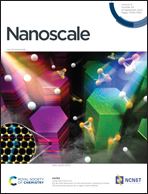Bidirectional tuning of phase transition properties in Pt : VO2 nanocomposite thin films†
Abstract
A phase transition material, VO2, with a semiconductor-to-metal transition (SMT) near 341 K (68 °C) has attracted significant research interest because of drastic changes in its electrical resistivity and optical dielectric properties. To address its application needs at specific temperatures, tunable SMT temperatures are highly desired. In this work, effective transition temperature (Tc) tuning of VO2 has been demonstrated via a novel Pt : VO2 nanocomposite design, i.e., uniform Pt nanoparticles (NPs) embedded in the VO2 matrix. Interestingly, a bidirectional tuning has been achieved, i.e., the transition temperature can be systematically tuned to as low as 329.16 K or as high as 360.74 K, with the average diameter of Pt NPs increasing from 1.56 to 4.26 nm. Optical properties, including transmittance (T%) and dielectric permittivity (ε′) were all effectively tuned accordingly. All Pt : VO2 nanocomposite thin films maintain reasonable SMT properties, i.e. sharp phase transition and narrow width of thermal hysteresis. The bidirectional Tc tuning is attributed to two factors: the reconstruction of the band structure at the Pt : VO2 interface and the change of the Pt : VO2 phase boundary density. This demonstration sheds light on phase transition tuning of VO2 at both room temperature and high temperature, which provides a promising approach for VO2-based novel electronics and photonics operating under specific temperatures.



 Please wait while we load your content...
Please wait while we load your content...